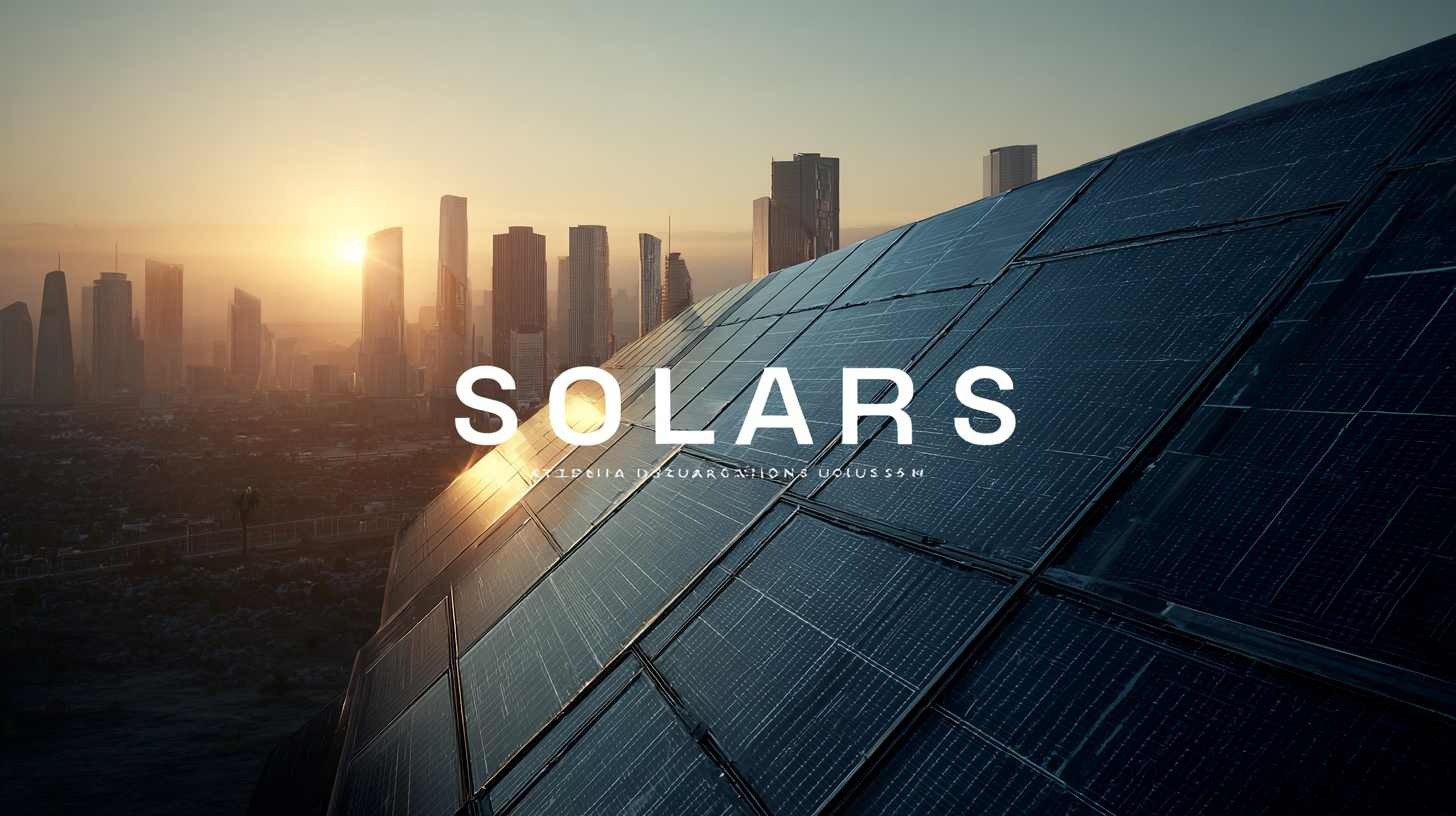Tel : 94870 36000, 94860 36000, 94890 36000
Exploring the Future of Solar Energy Innovations in 2025 with the Best Solar Panels Solutions
As we forge ahead into 2025, the landscape of energy production is undergoing a remarkable transformation, with solar energy at the forefront of this revolution. The advancements in technology not only promise increased efficiency but also introduce a variety of innovative Solar Panels Solutions designed to address the ever-growing demand for sustainable energy sources. This blog aims to explore the latest trends and breakthroughs in solar energy innovations that are shaping the future.

From enhancing the efficiency of solar panels to integrating smart technology for better energy management, we will delve into how these advancements are not just meeting current energy needs but also paving the way for a cleaner, more sustainable future.
Join us as we examine the potential of solar energy in 2025 and how these Solar Panels Solutions can contribute to a greener planet.
Table of Contents
[Hide]
Current Trends in Solar Energy Innovations Shaping 2025
As we look towards 2025, the solar energy sector is poised for remarkable transformations driven by innovative technologies and strategic investments. According to a report by the International Renewable Energy Agency (IRENA), the global solar capacity is expected to reach approximately 4,000 GW by 2025, a substantial increase from 2,700 GW in 2020. This shift highlights the growing commitment to renewable energy solutions and creates opportunities for advanced solar panel designs that enhance efficiency and reduce costs.
Current trends indicate a strong focus on bifacial solar panels, which capture sunlight on both sides, leading to up to a 20% increase in energy generation compared to traditional panels. Additionally, developments in energy storage systems, as reported by Bloomberg New Energy Finance, predict a 70% drop in battery prices by 2025. This will significantly enhance the usability of solar energy by allowing homeowners and businesses to store excess energy for later use, effectively smoothing out production and demand fluctuations. The confluence of these innovations is not only reshaping the solar landscape but also playing a crucial role in promoting sustainable energy practices worldwide.
Current Trends in Solar Energy Innovations Shaping 2025
Top Solar Panel Technologies Revolutionizing Energy Efficiency
As we look towards 2025, the solar energy landscape is rapidly evolving, driven by innovative technologies that significantly enhance energy efficiency. Recent collaborations, such as between leading research institutions and industry pioneers, are paving the way for AI-driven smart energy storage solutions that optimize the performance of solar panels. By harnessing artificial intelligence, these advancements enable smarter energy management, ensuring that renewable energy resources are utilized effectively, thereby maximizing output while minimizing waste.
The discovery of perovskite solar panels marks a significant milestone in the quest for high-efficiency energy solutions. This "miracle material" not only boosts the efficiency of solar panels but also reduces production costs, making solar energy more accessible than ever before. Coupled with innovative breakthroughs like solar paints designed to enhance electric vehicle charging efficiency, the future promises a synergistic relationship between renewable energy technologies and electrification. As smart technologies continue to redefine the renewable energy sector, we are witnessing a transformation that enhances reliability and accessibility, setting the stage for a sustainable energy future.
Exploring the Future of Solar Energy Innovations in 2025 with the Best Solar Panels Solutions
| Technology Type | Efficiency (%) | Cost per Watt ($) | Expected Lifespan (Years) | Innovations |
|---|---|---|---|---|
| Monocrystalline | 22-26 | 0.60-0.80 | 25 | Higher energy yield in low-light conditions |
| Polycrystalline | 15-22 | 0.50-0.70 | 25 | Lower production cost and energy loss |
| Bifacial | 20-25 | 0.75-0.95 | 30 | Captures sunlight from both sides |
| Thin-Film | 10-13 | 0.30-0.50 | 10-20 | Flexibility and lightweight advantages |
| Building-Integrated PV | 10-15 | 0.80-1.20 | 20-30 | Aesthetic integration into buildings |
Key Benefits of Adopting Advanced Solar Solutions for Homeowners
As the world moves towards a sustainable future, adopting advanced solar solutions has become increasingly advantageous for homeowners. The key benefits of these cutting-edge solar panels extend beyond mere cost savings; they embody a commitment to environmental responsibility. By harnessing solar energy, homeowners can significantly reduce their carbon footprint, contributing positively to the planet's health and promoting a cleaner, greener lifestyle.
Further enhancing the appeal of modern solar technology are the financial incentives associated with their usage. With innovations in efficiency and design, contemporary solar panels generate more energy in less space, allowing homeowners to maximize their investment. Many regions offer tax credits, rebates, and other incentives encouraging the transition to solar, making it not just an environmentally conscious choice but also a financially savvy one. Additionally, with advancements in battery storage systems, homeowners can store excess energy generated during sunny days, ensuring a steady power supply even during outages or less sunny periods. This shift towards energy independence is reshaping the way homeowners view their energy consumption and investment strategies.

The Role of Government Policies in Driving Solar Energy Advancements
As we look towards 2025, the role of government policies in advancing solar energy technologies will be crucial. Policymakers are increasingly recognizing the potential of solar power as a sustainable energy solution, and many are implementing frameworks that encourage innovation and investment. Incentives such as tax credits, grants, and subsidies for solar panel installations can significantly lower the cost barrier for both consumers and businesses, stimulating widespread adoption of solar energy solutions.
Moreover, regulatory measures that promote research and development in solar technology can lead to breakthroughs that enhance efficiency and storage capabilities. By supporting initiatives that foster collaboration among researchers, manufacturers, and startups, governments can catalyze a wave of innovation that propels solar technology into new territories. With ambitious targets for clean energy adoption set by various governments around the world, the synergy between robust policies and private sector innovation is expected to yield transformative advancements in the solar energy landscape by 2025.
Future Challenges and Opportunities for the Solar Energy Sector in 2025
As the solar energy sector gears up for 2025, it faces a landscape filled with both challenges and opportunities. One of the primary challenges is the need for enhanced energy storage solutions. As solar technology continues to advance, the intermittent nature of sunlight still poses a problem for consistent energy supply. Innovating battery technologies that can store excess energy generated during peak sunlight hours will be crucial for maximizing efficiency and reliability.

Moreover, the industry must address regulatory hurdles and the need for streamlined permitting processes. Governments around the world are increasingly recognizing the importance of renewable energy, yet bureaucratic red tape can stifle progress. By advocating for more efficient policies that support solar installations and offer incentives for both residential and commercial entities, the sector can accelerate adoption and create a more robust market.
On the opportunity front, advancements in solar panel technology, including bifacial and transparent panels, will open new avenues for installation in urban settings. These innovations can enhance energy generation while maintaining aesthetic value, making solar solutions more appealing to homeowners and businesses alike. As we approach 2025, the solar energy sector stands at a pivotal moment, ready to harness its potential for a sustainable and resilient energy future.

